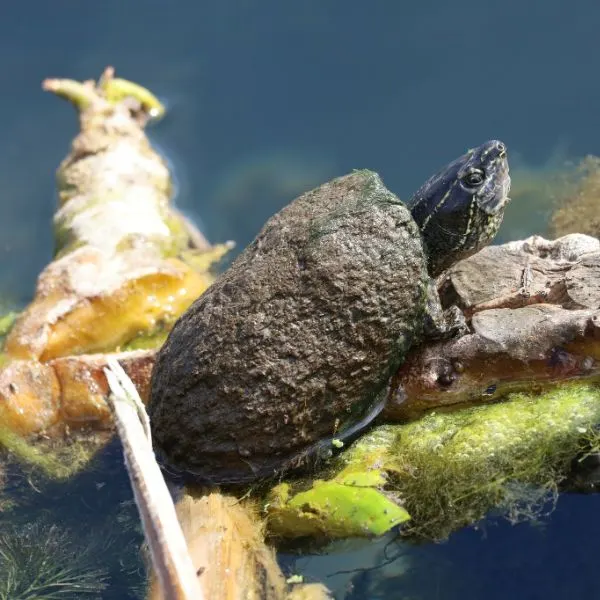Have you ever wondered about the different types of turtles you can find in Virginia? Well, let me tell you, there are 25 different species of these amazing creatures, including painted turtles, box turtles, pond sliders, snapping turtles, softshell turtles, map turtles, musk turtles, mud turtles, diamondback terrapins, and even sea turtles!
If you’re a turtle enthusiast like me, then you’ll love this identification guide that I’ve put together. It’ll help you recognize and appreciate the different types of turtles that can be found in Virginia.
But first, I want to make sure you understand the importance of not taking turtles from the wild. It’s not only harmful to the turtles themselves, but it also disrupts the ecosystem they live in.
Before considering owning a turtle as a pet, it’s important to check local laws to make sure you’re complying with regulations. Not all of the turtles mentioned here are legal to own in Virginia as pets, and some are illegal to own anywhere. So be sure to do your research before bringing one of these amazing creatures into your home.
Anyway, let’s dive into the world of turtles in Virginia and learn more about their fascinating traits and habits.
Table of Contents
Turtles in Virginia
1. Bog Turtle
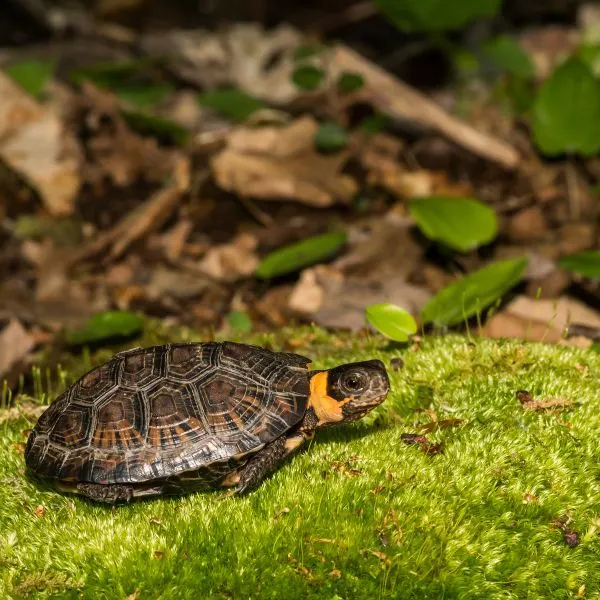
- Experience Level: Beginner
- Family: Emydidae
- Scientific Name: Glyptemys muhlenbergii
- Common Names: Muhlenberg’s Turtle
- Adult Size: 3.5 to 5 inches
- Lifespan: 40 years
These little guys are some of the smallest turtles you’ll find in North America! Bog turtles typically only reach about 4 inches in length and are just adorable.
They sport a very dark olive-green or black color and have bright red, orange, or yellow blotches on each side of their heads. Their omnivorous diet consists of insects, snails, slugs, worms, small rodents, nestling birds, frogs, and even berries and grains.
Bog turtles like to hang out in soft areas and love hiding in hollow logs. It’s important to give them a comfortable space to sleep on, such as some nice, dry shrubbery, compost, and leaves.
One of the coolest things about these little turtles is that they can recognize their owners and will even come out to greet you when it’s feeding time. Their small size and beady little eyes make them an attractive pet.
But here’s the thing, folks, the Bog turtle is actually a federally protected species and shouldn’t be kept as a pet. Let’s make sure to respect these tiny turtles and appreciate them in their natural habitat.
2. Spotted Turtle

- Experience Level: Intermediate to Expert
- Family: Emydidae
- Scientific Name: Clemmys Guttata
- Adult Size: 4 to 5 inches
- Lifespan: 25 to 50 years
- Average Price Range: $75 to $100
Spotted turtles are also small semi-aquatic turtles that people keep as pets. And let me tell you, they are a hit among turtle lovers!
But, here’s the thing, folks, if you’re thinking about getting one of these turtles, it’s important to note that they have some specific housing needs and require a certain diet. And let’s not forget that with any semi-aquatic turtle, you’ll need to put in a bit of effort to make sure they thrive.
The spotted turtle is easily identifiable by their white or yellow spots and black shell with either a light yellow or red underside. Females will have a reddish chin, while males will have a black one.
These little omnivores will chow down on everything from worms, slugs, and snails to fruits like melons or veggies like butter lettuce. They even like to snack on algae, soft aquatic plants, and water lily seeds.
Spotted turtles are active and curious creatures, but they can get stressed out when handled. So, it’s best to observe and appreciate them from afar. And let’s not forget that these little turtles can live for a really long time, making them a great companion for years to come.
3. Eastern Chicken Turtle

- Experience Level: Intermediate
- Family: Emydidae
- Scientific Name: Deirochelys reticularia reticularia
- Common Names: Chicken turtle
- Adult Size: 4 to 6 inches
- Lifespan: 20 to 24 years
- Average Price Range: $50 to $75
Next up is the Eastern chicken turtle. You might be wondering, “why they have such a strange name?” Well, apparently their meat tastes like chicken, which made them popular in southern markets at one time. But, let’s not go there, and focus on these cute turtles themselves.
Eastern chicken turtles are timid, yet alert creatures that love spending time in the water. They can even live with other chicken turtles and might be spotted basking together.
These omnivores love snacking on aquatic insects, amphibian larvae, and smaller fish like crayfish. But don’t worry, folks, that doesn’t mean you can’t be friends with them! They are just as friendly and lovable as any other turtle.
4. Wood Turtle
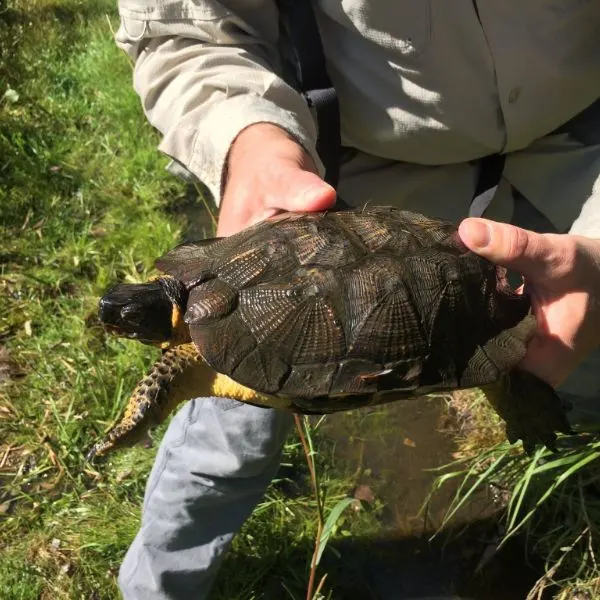
- Experience Level: Beginner
- Family: Emydidae
- Scientific Name: Glyptemys insculpta
- Common Names: Wood turtle or North American wood turtle
- Adult Size: 7 to 8 inches
- Lifespan: 40 to 58 years
Did you know that wood turtles are protected by the state and it’s illegal to sell or import any native or naturalized species of them under VAC 15-30-10?
These turtles are easily identified by their stunning red and black bodies and olive-green, black, or pale-yellow carapace with dark brown linings. They also have a mostly yellow plastron with black blotches along the bridge and outer edges.
Wood turtles are unique because they love both land and water, and this makes them omnivores. They enjoy eating a wide variety of foods such as snails, slugs, tadpoles, and sometimes even fish or mice. They also have a sweet tooth and will occasionally indulge in berries, mushrooms, and fruits.
Let’s appreciate these fascinating creatures and keep them protected in their natural habitat, so they can continue to thrive for years to come.
Painted turtles in Virginia
5. Eastern Painted Turtle
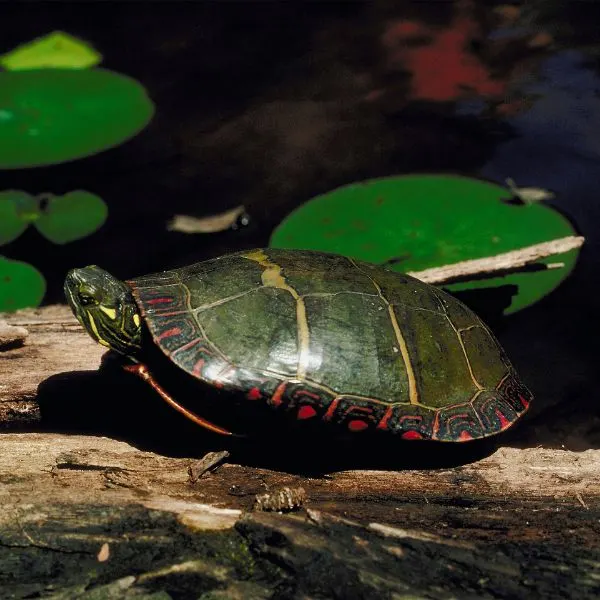
- Experience Level: Beginner
- Family: Emydidae
- Scientific Name: Chrysemys picta
- Adult Size: 4 to 10 inches
- Lifespan: 30 to 40 years
- Average Price Range: Between $20 to $50
The Eastern Painted turtle is a subspecies (there’s 4) of the Painted Turtle and they’re a great option for beginners looking to keep turtles. They’re small and can be kept indoors or outdoors.
These little guys have a smooth, dark olive or black shell with a slight rise in the middle. And they’re great swimmers! If you’re thinking of getting one, just make sure you have at least 20 gallons of filtered water for them.
When it comes to feeding, they’re not too picky. They’ll eat both plant and animal-based foods, so you can give them some lettuce, parsley, or even an apple as a treat.
Pond sliders in Virginia
6. Cumberland Slider

- Experience Level: Beginner
- Family: Emydidae
- Scientific Name: Trachemys scripta troostii
- Adult Size: 5 to 10 inches (Depending on gender)
- Lifespan: 40 to 50 years
- Average Price Range: $20 to $30
Cumberland Sliders are a popular choice for turtle enthusiasts as they make great pets. They are omnivorous and enjoy a varied diet that includes both commercial turtle pellets and fresh leafy greens like collard greens and romaine lettuce. Additionally, they will need protein sources from insects such as mealworms and crickets.
These turtles are friendly and social, which makes them great for people who want to interact with their pets. When young, they are more accustomed to handling than other species of turtles. In the wild, you might even see them basking together.
Although they may not have the brightly colored markings of their cousins, the Yellow-bellied and Red-eared sliders, Cumberland sliders are still easily identifiable by their olive-brown color and yellow markings on their carapace.
Cumberland sliders are excellent swimmers and can be found in quiet waters with a muddy bottom. To keep them healthy and happy, their enclosure needs to have a water temperature of around 70 to 75°F and a basking area of 90°F.
7. Red-eared Slider
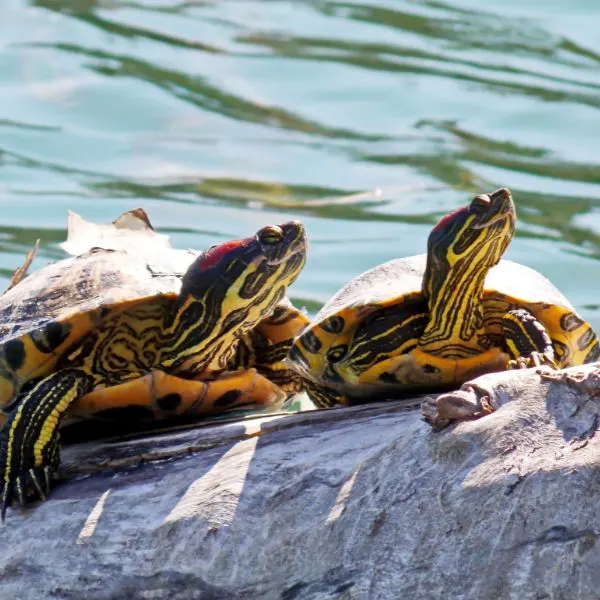
- Experience Level: Beginner
- Family: Emydidae
- Scientific Name: Trachemys scripta elegans
- Common Names: Slider Turtle, Red-eared Turtle, Red-eared Terrapin, Red-eared Slider Turtle
- Adult Size: 6 to 8 inches
- Lifespan: 20 to 40 years
- Average Price Range: $15 to $50
It’s worth noting that red-eared sliders are a popular and common pet turtle species, but they have also become an invasive species in many areas where they have been released or escaped into the wild.
That’s why it’s important to never release pet turtles into the wild and to only purchase them from reputable captive breeders that can ensure they are not taken from the wild illegally.
Additionally, it’s important to research the specific care requirements for red-eared sliders, as they have specific needs for their enclosure setup and water quality.
8. Yellow-bellied Slider

- Experience Level: Beginner
- Family: Emydidae
- Scientific Name: Trachemys scripta scripta
- Common Names: yellow-bellied terrapin
- Adult Size: 5 to 13 inches (depending on gender)
- Lifespan: 20 to 40 years
- Average Price Range: $15 to $50
Yellow-bellied sliders are also great swimmers and need plenty of room to move around. They’ll need an aquarium or enclosure with a basking area, UVB lighting, and a water filtration system.
Their diet is omnivorous and consists of both plant and animal-based foods. You can feed them commercial turtle pellets or a variety of vegetables such as dark leafy greens, carrots, and green beans. For protein, you can give them earthworms, crickets, or small pieces of cooked meat or fish.
It’s important to note that these turtles can live for several decades, so they are a long-term commitment. You should be prepared to provide them with proper care and attention for their entire lifespan.
Box turtles in Virginia
9. Eastern Box Turtle

- Experience Level: Beginner
- Family: Emydidae
- Scientific Name: Terrapene carolina carolina
- Adult Size: 4.33 to 7 inches
- Lifespan: 40 years
- Average Price Range: $120 to $400
Eastern box turtles are omnivores and eat a variety of foods including fruits, vegetables, insects, and small animals such as snails, earthworms, and slugs.
You can feed them a mix of commercial turtle food, fruits, and vegetables such as berries, carrots, and leafy greens.
Make sure to provide a shallow dish of water for drinking and soaking. It is important to note that wild-caught eastern box turtles should not be kept as pets, as they are a protected species in many areas.
Snapping turltes in Virginia
10. Common Snapping Turtle

- Experience Level: Intermediate to Expert
- Family: Chelydridae
- Scientific Name: Chelydra serpentina
- Common Names: Common snapping turtle
- Adult Size: 8 to 20 inches+
- Lifespan: 30 to 50 years+
- Average Price Range: Between $20 to $40
The common snapping turtle can be a challenging pet for those inexperienced with aggressive and territorial turtles. They can start out small, but grow to be quite large, and are identified by their sharp beaks and dark, almost-black brown shells with yellow accents on their limbs and tails.
These turtles are omnivorous and will eat almost anything, including aquatic vegetation, amphibians, freshwater fish, small mammals, bloodworms, shrimps, snails, cooked lean meats, crickets, mealworms, and earthworms. However, they can be quite aggressive and prone to hissing and snapping when they feel threatened or are being handled.
Snapping turtles do not bask much, but will occasionally float to the surface to warm up. Therefore, providing a UV light in their enclosure is important.
While snapping turtles may not be the cuddliest of pets, they are fascinating and fun to observe for those who have experience handling and caring for more aggressive species.
Softshell turtles in Virginia
11. Eastern Spiny Softshell
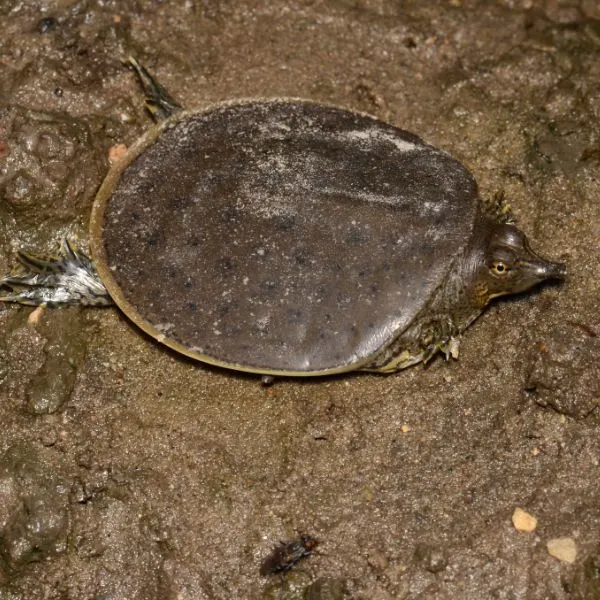
- Experience Level: Intermediate to Expert
- Family: Trionychidae
- Scientific Name: Trionyx spiniferus
- Adult Size: 5 to 9 inches for males; 9 to 11 inches for females
- Lifespan: 50 years
- Average Price Range: $20 to $50
The eastern spiny softshell is an aquatic turtle that has a soft shell, making them more vulnerable to attacks in the wild. Therefore, they require more care than other turtles.
These turtles have a unique appearance with a tentacle-shaped beak and a smooth, brown or olive-green body, sometimes with spots on their shell and yellow linings on their undersides.
In their natural habitat, they stay submerged in water, sand, or mud to hide from predators. To ensure their comfort, provide them with a sandy or muddy place to hide.
They are water-dependent creatures, and their oxygen is derived from the water through their special “gills”. Therefore, it is important to maintain clean water in their tank.
Eastern spiny softshells are predators and will eat anything they can catch in the wild, including fish, small crabs, snails, amphibians, and even small birds.
Map turtles in Virginia
12. Northern Map Turtle

- Experience Level: Beginner
- Family: Emydidae
- Scientific Name: Graptemys geographica
- Adult Size: 4 to 10.5 inches (Depending on Gender)
- Lifespan: 15 to 20 years
- Average Price Range: $20 to $60
The olive-green shell of the Northern Map turtle is adorned with dark markings that resemble the contours of a map or chart. They also have bright yellow stripes on their body, almost like a topographic map.
These active swimmers and baskers need ample space to swim around and bask on rocks or logs. They are omnivorous, and a diet of commercial aquatic turtle food, insects, and leafy greens will keep them healthy. Female Map turtles have stronger jaws to consume mollusks like snails, clams, and crayfish.
Map turtles make great pets for those who want a smaller-sized turtle that won’t grow as large as sliders or cooters. However, they still require a spacious aquarium to swim and bask in comfort.
These turtles are initially shy, but once they associate you with food, they will become friendlier and even beg for food during feeding time. It’s a good idea to get them as hatchlings to allow them to grow accustomed to you.
Mud turtles in Virginia
13. Three Striped Mud Turtle

- Experience Level: Beginner
- Family: Kinosternidae
- Scientific Name: Kinosternon Baurii
- Adult Size: 4 to 5 inches
- Lifespan: 50 years
- Average Price Range:
The three-striped mud turtle is a tiny aquatic turtle that prefers still or slow-moving bodies of water. They spend most of their time walking underwater, roaming the bottom of waterbeds. Unlike other turtles, they hardly ever bask and are rarely seen above water.
Their shell is characterized by three tan or pale-yellow stripes that run lengthwise, with some individuals having additional stripes on their face or body. Their body color is usually dark brown or black.
These omnivorous turtles have a varied diet that includes algae, plants, fish, insects, and snails. Although they are cute, they can be quite defensive and easily threatened. They have a sharp beak-like mouth that they will use to defend themselves.
If you’re looking for a small and unique pet, the three-striped mud turtle might be the perfect choice for you, but be prepared for their feisty personality.
14. Southeastern Mud Turtle

- Experience Level: Beginner
- Family: Kinosternidae
- Scientific Name: Kinosternon subrubrum subrubrum
- Adult Size: 3 to 5 inches
- Lifespan: 50 years
- Average Price Range: $40 to $100
The Southeastern mud turtle is similar to its sibling, the striped mud turtle, in that it prefers slow-moving or still water. Mud turtles are low-maintenance and small enough to live comfortably in a terrarium, as long as they have everything they need.
Unlike some other turtles, mud turtles don’t spend a lot of time swimming. They prefer to walk around and hide in their habitat. They also don’t bask in the sun as often as other turtles do.
Mud turtles require around 12 inches of water in their habitat, but they also need places to hide. They have smooth, dark shells that are typically dark olive-brown without any markings. Sometimes, their plastrons may have a yellow color with black blotches.
These turtles are omnivorous and enjoy eating water lily seeds, crustaceans such as crayfish, insects, mollusks, amphibians, and aquatic vegetation.
Similar to striped mud turtles, mud turtles can become feisty if housed with other turtles, and they may even kill each other. Males can become territorial and may attack unreceptive females. It’s important to keep these things in mind if you’re considering a mud turtle as a pet.
Terrapins in Virginia
15. Northern Diamondback Terrapin

- Experience Level: Beginner to Intermediate
- Family: Emydidae
- Scientific Name: Malaclemys terrapin
- Common Names: Diamondback turtle
- Adult Size: 4 to 5.5 inches
- Lifespan: about 25 to 40 years
- Average Price Range: $250 to $300
Northern diamondback terrapins are aquatic reptiles that reside in brackish waters such as shallow bays and tidal creeks. These unique turtles can be a bit difficult to find in the wild and are known to be anxious and stressed.
It’s important to note that the stress caused by captivity can lead to many health problems for these turtles, and they are actually illegal to own in many places.
These terrapins can be easily identified by the raised diamond-shaped markings on the highest point of their carapace, which can range in color from dark grey to almost black. Their skin is usually about the same color as their carapace, but sometimes it can be lighter. They also have dark blotches or spots on their bodies, making them quite unique.
If you do decide to keep a northern diamondback terrapin, you will want to add salt to their enclosure since they live in brackish, swampy waters with higher salinity levels. The optimal pH level for these turtles is around 6.8 to 7.0. They prefer a water temperature of about 76 to 78°F and love basking, so make sure to provide them with a good basking spot of around 90°F.
While they are not particularly hard to care for and aren’t known to be aggressive, even when stressed, it’s crucial to understand that their meat has become a delicacy in some areas, leading to overhunting and near-extinction of the species. It’s important to be mindful of the impact humans have on these fascinating creatures and to do our part to protect them.
Cooters in Virginia
16. Northern Red-bellied Cooter
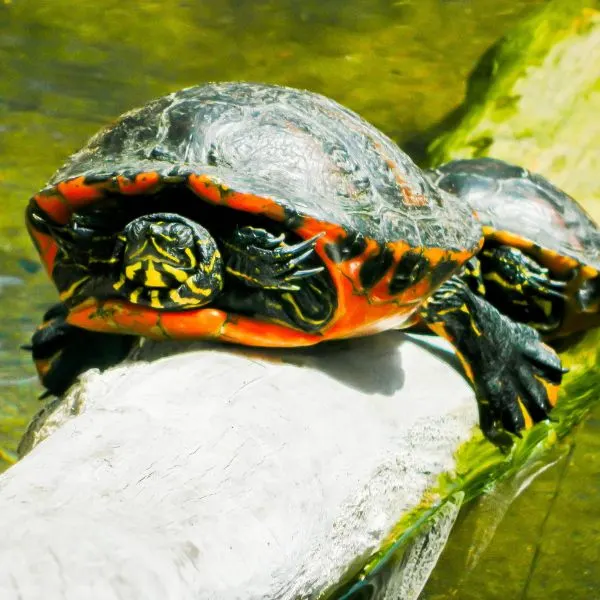
- Experience Level: Beginner to Intermediate
- Family: Emydidae
- Scientific Name: Pseudemys rubriventris
- Common Names: American red-bellied turtle
- Adult Size: 8 to 12.5 inches (depending on gender)
- Lifespan: 40 to 55 years
- Average Price Range: $30 to $90
The northern red-bellied cooter is the largest pond turtle species in North America and is also one of the most popular breeds kept as pets. Their beautiful red undersides are what give them their name and make them easy to identify.
These turtles generally have a mild temperament but may become slightly aggressive when around food or feeling threatened. When first introduced to a new home, they may be shy and retreat into their shells for a few days. However, they typically become more comfortable and will even come to greet you when you feed them.
If you’re considering a northern red-bellied cooter as a pet, keep in mind that they require a large tank with plenty of swimming room and basking areas. They need a water temperature of around 75 to 85°F and access to UVB lighting.
It’s also essential to provide a balanced diet consisting of both plant matter and protein sources such as insects or commercial turtle pellets. Overall, the northern red-bellied cooter is a fascinating and beautiful species of turtle that makes for an excellent pet for those who are prepared to meet their unique needs.
17. Eastern River Cooter
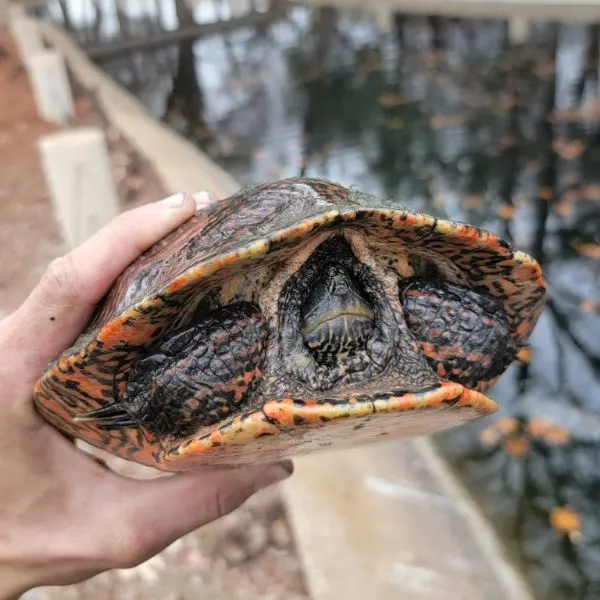
- Experience Level: Beginner to Intermediate
- Family: Emydidae
- Scientific Name: Pseudemys Concinna Concinna
- Common Names: River cooter
- Adult Size: 12 inches
- Lifespan: 40 years
- Average Price Range: $20 to $50
The Eastern River cooter is a freshwater turtle that can be easily identified by their broad, dark greenish to brown carapace and multiple yellow stripes on their head. They are commonly found in freshwater with a gentle current and heavy vegetation, where they enjoy swimming and hiding underwater for extended periods.
While they may occasionally be spotted basking in the sun, Eastern river cooters tend to retreat quickly into the water when approached by humans. These turtles can grow to be very large, so it’s essential to have adequate space for them in their enclosure.
Overall, the Eastern river cooter is a fascinating and unique species of turtle that can make a great addition to your home if you’re willing and able to provide them with the care they need.
18. Coastal Plain Cooter

- Experience Level: Beginner to Intermediate
- Family: Emydidae
- Scientific Name: Pseudemys concinna floridana
- Common Names: Coastal plain cooter, Florida cooter, pond cooter
- Adult Size: 15.6 inches max
- Lifespan: 40 years+
- Average Price Range: $20 to $50
The Coastal Plain Cooter is a freshwater turtle that can be easily identified by their smooth, dark brown-olive carapace, pale-yellow underbellies, and yellow-striped heads. These herbivorous turtles feed on aquatic vegetation and love to bask in the sun. They can be found in still waters such as marshes, ponds, and wetlands.
Coastal Plain Cooters are social creatures and can often be seen basking in groups. They are excellent swimmers and baskers, so if you’re considering keeping one as a pet, it’s important to provide a deep-water aquarium with a good spot for basking under a light.
To keep them healthy, water temperature should be around 75°F, and the basking spot should be about 85°F. These turtles are quite active and can grow to be quite large, so a 100-gallon tank or more is recommended.
While they can be omnivorous and occasionally prey on invertebrates, this behavior is more common in male cooters than females. Overall, the Coastal Plain Cooter is an interesting and beautiful species of turtle that makes for an excellent pet for those who are prepared to meet their unique needs.
Musk turtles in Virginia
19. Stripe-necked Musk Turtle

- Experience Level: Intermediate
- Family: Kinosternidae
- Scientific Name: Sternotherus minor peltifer
- Common Names: Loggerhead Musk Turtle
- Adult Size: 3 to 4.5 inches
- Lifespan: About 50 years+
- Average Price Range: $20 to $60
The Stripe-necked musk turtle, a subspecies of the Loggerhead musk turtle, is a fast-moving and quick-nipping reptile that can be easily confused with its sibling. However, you can differentiate them by the yellow stripes on their necks and the shapes of their heads.
These turtles are mainly carnivorous and feed on crayfish, mollusks, and aquatic insects, but they may also consume plants from time to time. As messy eaters, it’s essential to have a high-quality filtration system in their enclosure.
Stripe-necked musk turtles prefer a basking temperature in the mid-80s to low 90s Fahrenheit, and being aquatic turtles, they will mostly stay in the water. They can be found in similar areas as their sibling, the Loggerhead musk turtle.
It’s worth noting that musk turtles have a defense mechanism where they release a foul-smelling secretion when they feel highly stressed or threatened. Therefore, it’s important to keep this in mind if you’re considering owning a musk turtle.
While caring for these turtles is similar to their sibling, the Loggerhead musk turtle, the Stripe-necked musk turtle is a fascinating and unique species of turtle that can make a great addition to your home if you’re willing and able to provide them with the care they need.
20. Eastern Musk Turtle
- Experience Level: Intermediate
- Family: Kinosternidae
- Scientific Name: Sternotherus odoratus
- Adult Size: 4 to 5 inches
- Lifespan: 50 years +
- Average Price Range: between $20 to $70
The Eastern Musk turtle, also known as the “Stinkpot turtle,” is a small and unique species of turtle that can make a great pet if you don’t mind their musky odor. They have the ability to release a strong odor from their scent glands to deter predators, which some have described as skunk-like.
Despite their odor, Eastern Musk turtles are small in size and not too difficult to care for, making them a great choice for some pet owners. They can be identified by their narrow, highly-arched or domed, blackish-brown shell and body, as well as the yellow or light-yellow stripe behind their eyes.
These turtles are primarily carnivorous and enjoy a diet of leeches, mollusks, larval and adult insects, and even tadpoles. While they may not leave the water often, it’s essential to provide them with a basking point of around 80 degrees Fahrenheit.
If you’re considering an Eastern Musk turtle as a pet, it’s important to note their unique care needs. They require a tank with both swimming and basking areas, as well as a water temperature of around 75 to 80°F. Additionally, their diet should be properly balanced with both protein and plant matter.
Overall, the Eastern Musk turtle is a fascinating and unusual species of turtle that can make for an interesting and unique pet for those willing to tolerate their musky odor.
Sea Turtles in Virginia
During late spring, when the water temperatures rise, thousands of sea turtles migrate (up to 10,000) into Chesapeake Bay to feed. Loggerheads and Kemp’s Ridley sea turtles are the most commonly seen, but green sea turtles and leatherback sea turtles have also been spotted, with the hawksbill sea turtle appearing in the Bay occasionally.
While green sea turtles are the most commonly kept as pets due to their undemanding nature and ease of care, it’s essential to understand that all sea turtles are protected under the Endangered Species Act and should not be kept in captivity.
These magnificent creatures thrive in the vast, open space of the ocean, where they play a critical role in maintaining healthy seagrass beds and transporting vital nutrients from beaches and coastal dunes to coral reefs, which provide habitats for other marine life.
As such, it’s essential to protect sea turtles at all costs, as their important role helps keep food webs balanced, which is a vital aspect of ocean life. If you’re hoping to spot these amazing creatures in the wild, understanding the unique characteristics of each species can help you identify them.
21. Loggerhead Sea Turtle

- Family: Cheloniidae
- Scientific Name: Caretta caretta
- Adult Size: between 35 inches and 3 feet
- Weight: 154 pounds
- Lifespan: 70 to 80 years
- Conservation Status: Endangered
- Habitat: Shallow, subtropical coastal regions
- Recommended Books:
- Clutch Size: 100 to 125 eggs; nesting 4 to 5 times per season
The Loggerhead sea turtle is a carnivorous species that primarily feeds on clams, conches, and crabs. They have hard shells with a reddish-brown color, a yellow underbelly, and long flippers, along with a large head with a defined jaw.
22. Kemp’s Ridley Sea Turtle

- Family: Cheloniidae
- Scientific Name: Lepidochelys Kempii
- Adult Size: About 25 inches
- Weight:77 to 100 pounds
- Lifespan: 30 years
- Conservation Status: Critically endangered
- Habitat: Shallow muddy or sandy coastal lines
- Clutch Size: 100 to 110 eggs; nesting 2 to 3 times per season
The Kemp’s Ridley Sea turtle primarily feeds on crabs, particularly blue crabs, but will also consume shrimps, clams, and mussels. They have a distinctive triangular head with a slightly hooked beak and a greyish-green, circular carapace with a light yellow or cream plastron. Their undersides may also be a pale yellow to cream color.
23. Green Sea Turtle

- Family: Cheloniidae
- Scientific Name: Chelonia Mydas
- Adult Size: 3 to 4 feet
- Weight: 300 to 400 pounds
- Lifespan: 80 to 100 years
- Conservation Status: Endangered
- Habitat: Tropical and subtropical waters in bays and shores by the coastline; anywhere with seagrass beds
- Clutch Size: 110 to 115 eggs; Nesting 2 to 5 times per season
The Green sea turtle is primarily herbivorous, feeding on seagrass, seaweed, and occasionally algae. Younger individuals may also consume worms, aquatic insects, or small crustaceans. They have non-retractable, small heads and a heart-shaped, brown carapace, with a greenish hue on their scaly skin. They also have a cream-colored underside and beady eyes.
24. Leatherback Sea Turtle
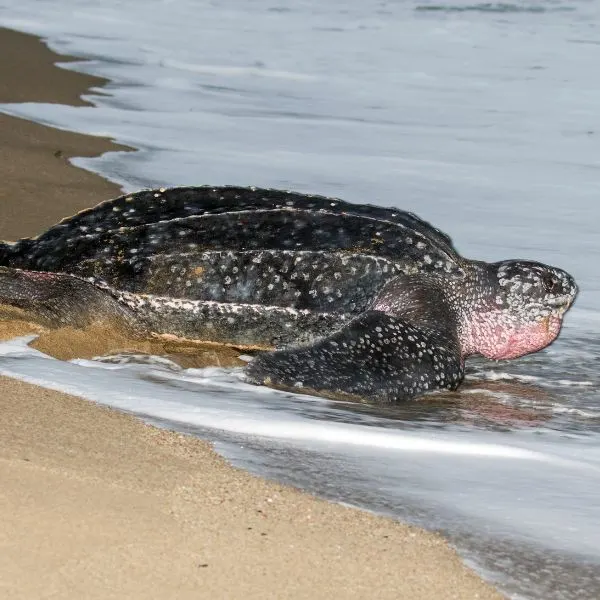
- Family: Dermochelyidea
- Scientific Name: Dermochelys Coriacea
- Adult Size: About 6 to 7 feet
- Weight: Between 1200 and 1450 pounds
- Lifespan: 30 years
- Conservation Status: Vulnerable
- Habitat: They like warm waters and can be found in every ocean except the Arctic. They will inhabit calm, shallow lagoons or bays. They love to nest on sand, sloped beaches with good vegetation.
- Clutch Size: 100 to 110 eggs.
The Leatherback sea turtle mainly feeds on jellyfish, although they will occasionally consume some fish and other marine creatures. It is the only sea turtle that lacks a hard shell, instead having a dark grey to black-colored shell with scattered white spots or blotches. Their carapace is elongated and flexible, featuring long ridges running down its length.
25. Hawksbill Sea Turtle

- Family: Cheloniidae
- Scientific Name: Eretmochelys Imbricata
- Adult Size: 30 to 35 inches
- Weight: between 100 to 155 pounds
- Lifespan: About 30 to 50 years
- Conservation Status: Critically Endangered
- Habitat: Tropical, rocky waters, mangroves, lagoons, or near tropical coral reefs.
- Clutch Size: Anything from 140 to 200 eggs; Nesting about 4 times each season or every 2 weeks
The Hawksbill sea turtle is an omnivorous species, feeding on a variety of foods such as sea urchins, jellyfish, mollusks, marine algae, and sponges. They have a unique beak-like mouth, which resembles that of a hawk. They have an elongated, oval-shaped, amber-colored shell with distinctive patterns, giving them their name. Their amber flippers also have claws at the “elbows.”
Wrapping up
In Virginia, there are a diverse range of turtles that inhabit the state, each with their own unique characteristics and behaviors.
From the freshwater turtles like the Northern Diamondback Terrapin, to the sea turtles like the Loggerhead and Kemp’s Ridley, there are plenty of species to admire and learn about.
While some turtles make great pets, it’s important to remember that many are protected under the Endangered Species Act and thrive best in their natural habitat.
Turtles in Virginia play a crucial role in maintaining healthy ecosystems and should be protected at all costs. By learning about and appreciating these fascinating creatures, we can help ensure their survival for generations to come.
Other nearby states

